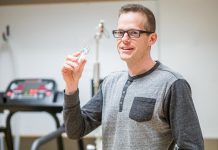December 2002 � A collaboration of scientists from Harvard Medical School and Dartmouth Medical School has developed a new mouse model of lipoatrophic diabetes, and highlighted leptin therapy as a successful tool to combat this rare form of type II diabetes.
Lipoatrophic diabetes mellitus is characterized by a lack of subcutaneous fat (lipoatrophy), high blood sugar (hyperglycemia), and high blood insulin (hyperinsulinemia). Because patients with lipoatrophic diabetes are insulin-resistant, although high levels of insulin accumulate in their bloodstream, glucose is not efficiently delivered to their body's cells, eventually resulting in severe eye, kidney, nerve and cardiovascular problems. A relatively rare disease in humans, lipoatrophic diabetes is thought to have a strong genetic component.
With the new model of lipoatrophic diabetes that Dr. Ronald Kahn and colleagues have developed, scientists are gaining valuable insight into the genetic pathway of this disease. "This model also points out how two genetic traits, neither of which alone can produce diabetes, can interact to produce a very severe diabetic state," states Dr. Kahn.
Dr. Kahn and colleagues were interested in elucidating the roles of the four insulin receptor substrate protein family members (IRS-1, -2, -3, and �4; the substrates for the insulin and insulin-like growth factor receptors) in insulin signal transduction and metabolism. IRS single knock-out mice had been previously made, and although the IRS-3-deficient mice showed no abnormalities, and the IRS-4-deficient mice showed only slight growth retardation and glucose intolerance, mice deficient in IRS-1 or IRS-2 displayed severe (but different) phenotypes.
Dr. Kahn and colleagues suspected that in IRS single knock-out mice the presence of the remaining three functional IRS genes could possibly compensate for the loss of one IRS gene and thereby obscure its true physiological function. Thus, the researchers generated two different strains of so-called "double knockout mice" � mice deficient in two genes: IRS-1 and IRS-3 or IRS-1 and IRS-4.
Continue Reading Below ↓↓↓
While the IRS-1/4 double knock-out mice were indistinguishable from the IRS-1 single knock-out mice (indicating no functional overlap between the IRS-1 and IRS-4 genes), the IRS-1/3 double knock-out mice had a markedly different phenotype. Like humans with lipoatrophic diabetes, the IRS-1/3 double knock-out mice displayed severe lipoatrophy, hyperglycemia, hyperinsulinemia, and insulin resistance. However, unlike previous models of lipoatrophic diabetes, the IRS-1/3 double knock-out mice did not accumulate fat in their liver and muscle, demonstrating that the increased deposition of fat in liver and muscle is not a requisite feature of lipoatrophic diabetes.
In addition to serving as a novel model of lipoatrophic diabetes, the IRS-1/3 double knock-out mice also reveal that IRS-1 and IRS-3 have partially redundant roles in mouse adipogenesis (fat development). Since humans do not have a functional copy of the IRS-3 gene, the authors propose that IRS-1 may thus play a more significant role in human adipogenesis and insulin homeostasis than it does in rodents, as there is no IRS-3 to compensate for mutations in, or loss of, IRS-1. In light of this, the IRS-1/3 double knock-out mice "may more closely mimic what happens in humans when the levels or sequence of IRS-1 is altered (since there is no IRS-3 to compensate)," explains Dr. Kahn.
Interestingly, Dr. Kahn and colleagues were able to completely reverse the hyperglycemia and hyperinsulinemia of the IRS-1/3 double knock-out mice within six days through the administration of the fat cell-secreted protein leptin � suggesting that leptin therapy may also prove successful in the treatment of humans with lipoatrophic diabetes.
Source: Cold Spring Harbor Laboratory









